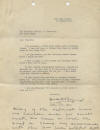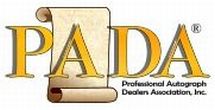815801
Richard E. Byrd
Scroll down to see images of the item below the description
Byrd reports to the President on a secret mission to the South Pacific:
“Dear Franklin . . . We have already investigated twenty-one islands and surveyed ten. . . .
Many of the islands have no harbor even for small boats. We have to ride the surf to shore.
My experience with this has been helpful."
Richard Evelyn Byrd, Jr., 1888–1957. Pioneering American aviator and polar explorer. Superb Typed Letter Signed, Dick Byrd, with autograph postscript signed Dick, one page, quarto, Bora Bora Island, October 27, 1943. With accompanying cover Autograph Note Signed, Dick Byrd, one page, small octavo, [no place, no date].
This is an extraordinary pair of World War II-dated pieces. About half way through, Admiral Byrd reports to President Franklin D. Roosevelt on his secret mission to the South Pacific to seek out obscure islands as refueling bases for military use and for post-World War II commercial flights. These two pieces include Byrd's letter to Roosevelt, whom he addresses informally as “Dear Franklin,” and a cover note to Roosevelt's secretary, Grace Tully. Byrd sends stamps for the President's collection and reports on his important survey of Southeastern Pacific islands. He notes his own escape from an accidental gasoline explosion aboard his flagship, the USS Concord, that damaged the ship and killed 24 crew members.
Byrd writes the President: “I am enclosing a first stamp issue cover of Pitcain Island. . . . / I am also sending you two Christmas Island stamps which I think are rare. / I have a couple of rare stamps and envelopes which I don't dare send by mail. / We have already investigated twenty-one islands and surveyed ten. We are able to do this quickly because we prepared very thoroughly for the job. I have about eight more islands to survey. / We lost twenty-four men from an explosion several weeks ago. This included the executive officer, Commander Rogers Elliott, who was a very splendid man. We buried them all at sea, it was a sad affair. / I was standing near the explosion and was lucky to come out o.k." In a handwritten postscript, Byrd writes: “Many of the islands have no harbor even for small boats. We have to ride the surf to shore. My experience with this has been helpful."
Byrd adds in his cover note to Tully: “Howdy Grace Tully! Wish you were with us. Interesting."
From August 27 to December 5, 1943, Byrd and his crew surveyed 33 South Pacific islands. Roosevelt aide George McKee Elsey entertained Byrd at the White House when he came to report to Roosevelt on the mission. Elsey, a Navy lieutenant who had supervised the White House Map Room and who by this time was an aide to Rooseveltʼ Naval aide Admiral William D. Leahy, recounts that Byrd's mission was “so confidential that we were keeping it secret from our closest ally, Britain." The explosion on board the Concord, however, was “serious enough to cause Byrd to break radio silence and report he was heading for the nearest port. The British picked up the broadcast. Irked at the unexplained presence of an American cruiser in ʻtheirʼ are of the Pacific, they asked for an explanation. They, too, were thinking ahead to post-war civilian aviation and had their eyes on strategically placed islands." George McKee Elsey, An Unplanned Life 72 (2005).
The United States maintained landing strips and facilities on a number of Pacific islands during World War II. Bora Bora, the South Pacific crown jewel of French Polynesia from which Byrd wrote this letter, served as an American military supply base, oil depot, airstrip, and seaplane base. The base was closed in 1946, but abandoned American guns serve as a lasting reminder of Bora Bora's military role.
Roosevelt and Byrd became close friends early in World War I, when Roosevelt was Assistant Secretary of the Navy and Byrd was assigned to the USS Dolphin, which FDR occasionally used to transport himself and his family. They remained close in the following years. Byrd's use of Rooseveltʼs given name, however, was extraordinary, particularly for an admiral to his Commander In Chief. Elsey observed that even Harry Hopkins, who was FDRʼs closest friend and confidant, called him “Mr. President." Elsey heard only three people use Roosevelt's given name: Eleanor Roosevelt and Winston S. Churchill, who called him “Franklin,” and Supreme Court Justice Felix Frankfurter, who called him “Frank." Elsey at 62.
Roosevelt awarded Byrd the gold star in 1940 in recognition of his service as commander of the U.S. Antarctic Expedition. For his work on this South Pacific expedition, Roosevelt awarded him the Legion of Merit. The citation said that Byrd received the Legion of Merit for
exceptionally meritorious conduct in the performance of outstanding services to the Government of the United States while in command of a Special Navy Mission to the Pacific from 27 August 1943 to 5 December 1943 when thirty-three islands of the Pacific were surveyed or investigated for the purpose of recommending air base sites of value to the United States for its defense or for the development of post-war civil aviation. In this service Admiral Byrd exercised fine leadership in gaining the united effort of civilian, Army, and Navy experts. He displayed courage, initiative, vision, and a high order of ability in obtain data and in submitting reports which will be of great present and future value to the National Defense and to the Government of the United States in the post-war period.
FDR awarded Byrd yet another gold star, in lieu of a second Legion of Merit, for his work “as Confidential Advisor to the Commander in Chief, United States Fleet and Chief of Naval Operations" before and after this South Pacific mission. His “wise counsel, sound advice and foresight in planning,” the citation read, "constituted a material contribution to the war effort and to the success of the United States Navy."
As President, Roosevelt was the world's most famous stamp collector. During his presidency, philately became the world's most popular pastime. Roosevelt's parents introduced him to the hobby when he was eight years old, and throughout the years he assembled a huge collection containing dozens of albums with stamps from virtually every country. Wherever he traveled, including to Casablanca and Yalta during World War II, he took his collection along. Shortly before he collapsed and died from a massive cerebral hemorrhage on April 12, 1945, he approved the design for the new “Toward United Nations" stamp and spent an hour with his collection.
Byrd has signed the letter and added the postscript in black fountain pen. There are two horizontal mailing folds. The letter shows a bit of handling, and it has filing holes at the top and paper clip impressions and stains in the blank top and left margins. The accompanying note to Tully has corresponding paper clip impressions and stains at the top and one horizontal fold, none of which affects the text or the signature. Overall both pieces are in fine condition.
Unframed.
Click here to see more items from aviation and World War II.






